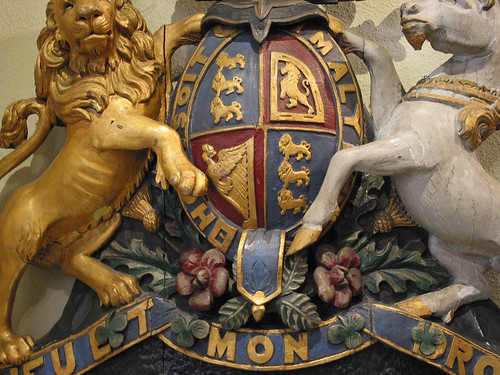Key pointer to change in a stage performance is the passage of people – an empty stage is a far greater marker of end/beginning than the written word ‘
exaunt’ (with or without a new scene or act number).
 The flow of people onto the stage – sometimes with a musical accompaniment, sometimes silently or with the clashing of weapons, the marching of feet and waving of banners – is an important stimulus to pay attention – something new is going to happen; the draining away of all, leaving a bare wooden platform, is a sure fire kick-start to the question, ‘Well, what was all that about then?’
The flow of people onto the stage – sometimes with a musical accompaniment, sometimes silently or with the clashing of weapons, the marching of feet and waving of banners – is an important stimulus to pay attention – something new is going to happen; the draining away of all, leaving a bare wooden platform, is a sure fire kick-start to the question, ‘Well, what was all that about then?’

Part of the difficulty of ‘reading’ a play like The First Part of the Contention … is this lack of definition – I am tempted to say it is the difference between seeing a postcard of Nelson on his column and being in Trafalgar Square, pigeons, traffic, tourists and all.
Paradoxically, a greater clarity of the individuality of scenes also leads to a sense of cohesiveness: Humans love to sum the parts.
It is a mistake to over emphasis the narrative as sole foundation upon which Shakespeare is building. It is a mistake easy to make – especially with the History Plays which are based on a national narrative, pre-written and only adapted by the word-play-forger.
The director in me (small, sniveling, unfulfilled, deflated, vestigial lump that it is) never lets go of Shakespeare’s love of juxtaposition. Examine any two scenes he placed next to each other and you will usually find a wealth of links – frequently, but not exclusively, in the form of a contrast. Put three scenes side by side and the sum becomes greater than the parts.
Act 2 of The First Part of the Contention (Henry VI, Part 2) provides an example in scenes 2,3 and 4.
Quite frankly, they are not a good read.
We have a complicated spoken genealogy guaranteed to confuse, even when re-read; a scene that seems to be taking place in a court – possibly a public execution place – with a short announcement and bit of a fight; then a scene in a street with more talk and next to no action: Nothing happens twice with a bit of physical distraction in-between.
Overtly scene 2 is York’s explanation of why he is the rightful heir to the throne and why Henry is an usurper. It is possible to dig out a genealogical table and follow his argument (although beware – Shakespeare, copying his source closely, gets a bit of it confused) – and come to the conclusion, ‘he has a point’.
Legally then, York should be King – but Shakespeare doesn’t leave it there – he adds a coda. When Salisbury and Warwick have knelt and declared him King, York goes on to suggest the need for all three to be deceitful and pretend to be what they are not – with the purpose of disposing of Gloucester, ‘the shepherd’.
At which point Mr Shakespeare empties the stage.
So – what was that all about?
We have a justified legal claim which sounds like ‘words, words, words’, and an intended illegal action in promotion of that claim. Do actions subvert rights? If York gets the crown this way is he in rightful possession?
By which time the trumpets are sounding and in walks the un-rightful king – in full splendour (complete with the crown) and power. He gives judgment in a court case – sentences, in full public view and with assurance (and a glimpse of god’s anointed majesty) to death evil-doers and, with rightful distinction, to internal exile their silly dupe (Gloucester’s wife). The language used is clear, straight and unambiguous.
The criminals go off to ‘execution’ and in come the master and apprentice for the trial by combat. One is drunk and getting drunker – the other almost insensible with fear. The drunk has pro-claimed York true King and is assured victory by both experience and physical size; the apprentice – and that meant boy – has no chance, even though right is on his side.
But a ‘miracle’ happens – the excessive drink confounds the man and the boy wins.
Watching this is Henry, the ‘young’ King, York, Warwick, and the rest of the court … including all of those mentioned in the previous scene as subverters of the state and its laws.
York, in two quick lines, sees not the actions of God, but the wine as cause of the victory; Henry, closing the scene in 6 lines (looking always for the interventions of God) heaven’s intent to punish and bring low the unrighteous, reward those true.
And the stage empties again … with trumpets and display, cheering and the dragging off of a dead body.
Clearly there is a demonstration of ‘right over might’ – but York was on stage – and all those lords he was talking about … is Henry falsely secure?
And where were the combatants standing? Was Henry ‘above’ and the fight below? Where was York (and his friends) standing in the scene before? If York, then the witch and Gloucester’s wife, then the fight are all seen on the same spot – they are linked.
Why the drink? The previous scene took place after the Lords had dined together – were any of them slightly drunk? (It would make for a more entertaining scene if Warwick was slightly tipsy). Excessiveness in drink is a metaphor for other excessiveness – and the armorer was the one who supported York’s claim to the throne – is there truth in wine or is it just oil for the wheels on the tumbrel?
In silence, Gloucester enters. He is here to watch his wife’s punishment and penance – was he ordered to?
 Eleanor Cobham enters – dressed in a simple white sheet (a shroud? Memento mori? Gloucester and his servants are is mourning black).
Eleanor Cobham enters – dressed in a simple white sheet (a shroud? Memento mori? Gloucester and his servants are is mourning black).
Gloucester refuses to break the law and rescue her – but she, apparently learning nothing from her experience, berates him for allowing her public disgrace. She invokes the image of Gloucester as a bird when she says a bush is being limed for his capture. Gloucester gently rebukes her and tells her to keep faith with the laws of the land – she is being rightly punished for a crime she did commit. She warns him that he will not live long – he is next in line for the chop.
She is taken off to the Isle of Man and Gloucester leaving earlier to go to the King’s parliament. Eleanor’s words close the scene – no matter how well dressed, she will always bear the ‘shame’ of the shroud.
The biggest contrast between scenes 3 & 4– and surely the one with the initial impact – is the costume: Scene 3 is all colour, all state, all heraldic splendor – Eleanor Cobham is still ‘Duchess’ and is in her finery, the King in his robes of state, and the peers of England resplendent; Scene 4 is plain black and then white – the black of mourning and the white of the dead. There is the martial uniform and weapons of the Sheriff and his men encasing the woman ‘caught in sin’ … and a brief reminder, in the person of the herald, of the previous colourful scene.
Eleanor’s closing words force us to think back to the previous scenes – and point to the future – we cannot hide our guilt in our surface appearances. It is a common enough theme in Shakespeare – no less significant for its ubiquity.
 These juxtapositions reveal interesting aspects of the play which might not be noticed as so significant if analysis is restricted to any individual scene (or the play ‘as a whole’) – but what happens if we look at the three of them as a triptych?
These juxtapositions reveal interesting aspects of the play which might not be noticed as so significant if analysis is restricted to any individual scene (or the play ‘as a whole’) – but what happens if we look at the three of them as a triptych?
One element that strikes me is the intensity with which the relationship between legality and right is put under the spot light.
It is clear that York has a legal claim to the throne – but has he any ‘right’? The first doubt to his claim is found within the scene where he expounds that right – he is willing to cheat, lie and play false in order to win. This is immediately brought into contrast with the Kingly Henry – for the first time (and possibly last) behaving as a true king – and with the condemnation of those who plot against the rule of God and the state. The fight then emphasises the ultimate exposure of such falsity even when supported by might. The drunkenness suggests an excessive intoxication as a cause of ultimate failure, which is a point acknowledged by York – but not absorbed.
The failure to act moderately results in death – both the physical death of the man (as the body carried off at the end of the third scene clearly indicates) and the spiritual death of Eleanor Cobham – who goes to her exile not repenting her sin, but repenting her fall.
Eleanor Cobham and York are paired in these three scenes – both have been driven by ambition, both are playing the Devil’s game, both wish to abuse the laws of the land for personal gain.
Henry appears in the central scene as a right acting rock standing against a battering sea of false aristocracy – he is ‘Peter’ – the name given to the winning apprentice – and the true rock on which the foundations of Christianity are laid. He has a blind faith in right winning out in the end. But we mustn’t forget - true justice is blind!
Which pairs him with Gloucester – the ‘Good Duke Humphrey’ of the plays original, full title. For in the fourth scene Gloucester makes the claim that he cannot be harmed because he has committed no crime.
The second scene has prepared us to hear these words with a dramatically ironic ear – we know the plots and traps being laid for the old man, the limed twigs that will snare him – but we have also just seen right winning in the end. If York and Gloucester’s wife are linked – then the ultimate fate of both is also linked and no matter what deceptions York contrives, in the end he will be made to do penance for his crimes – and go to punishment after that penance.
It is worth remembering that Shakespeare’s play, despite its verisimilitude, has taken a great liberty at this point – it has moved the events of 1442 when Gloucester’s wife and the others were tried and condemned forward to 1448 when York and his two friends met in the garden. This is not the accidental juxtapositioning of chronology – it is the deliberate artistic mixing of disparate events in a unified space.

































